|
 | Anglo Saxon History |  | |
| | The Saxon Kingdom of the Haestingas |
|---|
| |
|---|
| The Haestingas a logic puzzle |
|---|
What do we know about them and what can we deduce ?
All maps shown in this presentation have been derived from Google Maps
(My Maps)
| | |
|---|
| What do we actually know ? ▲ |
|---|
- 771AD the chronicler Simeon of Durham records the defeat of the gens Hestingorum (the people of Hastings) by
King Offa of Mercia
- Alfred the Great had a mint and a Burh(Large Fort) at Hastings
| | |
|---|
| What else do we know that might have relevence ? ▲ |
|---|
- The area around Hastings has village names that are of Saxon origin.
- The Great Forest of Andredsweald - Anglo
Saxon Chronicles was in the Hastings area.
- The coastline was much different to today due to erosion and high tide level changes.
Landscape - Was the sea level in Saxon
times at Pevensey 4 to 5 metres higher ?
- The Romans had industrialised the area to produce iron and ships.
Roman Ironworking in the weald and why it
declined
- The Jutes and Saxons appear to have settled westwards from Kent along the south coast according to the Anglo Saxon
Chronicles.
- 449AD Henghest and Horsa(Jutes) arrived in Kent to help Wurtgern(Vortigern).
- 457AD Henghest and Horsa(Jutes) controlled all of Kent
- 477AD Aelle landed at Cymensora(Shoreham)
- 491AD Aelle and Cissa(Saxons) besieged Anderida , near Pevensey.
- 495AD Cerdic and Cynric land at a place that is called Cerdic's-ore (Ichenore).
- 501AD Port and his two sons, Beda and Mela, landed at Portsmouth.
- 514AD The West-Saxons landed at the place that is called Cerdic's-ore.(Ichenore)
- 692AD Nothhelm, king of Sussex, grants to his sister Nothgyth, 33 hides at Lidsey, Aldingbourne, Lenstedegate and
Mundham Sussex to found a minster, this is signed by two kings, Nothhelm of the South Saxons and Watta possibly of
Hastings.
-
771AD Abbot Sibald died; and Egric and Lector' passed
from the course of this transitory life to the fellowship of the elect,
where he takes up an endless song of triumph. At this time Offa,
king of the Mercians, subdued by arms the people of the Hestingi.
| | |
|---|
Details of the Coastline at the time ▲
|
|---|
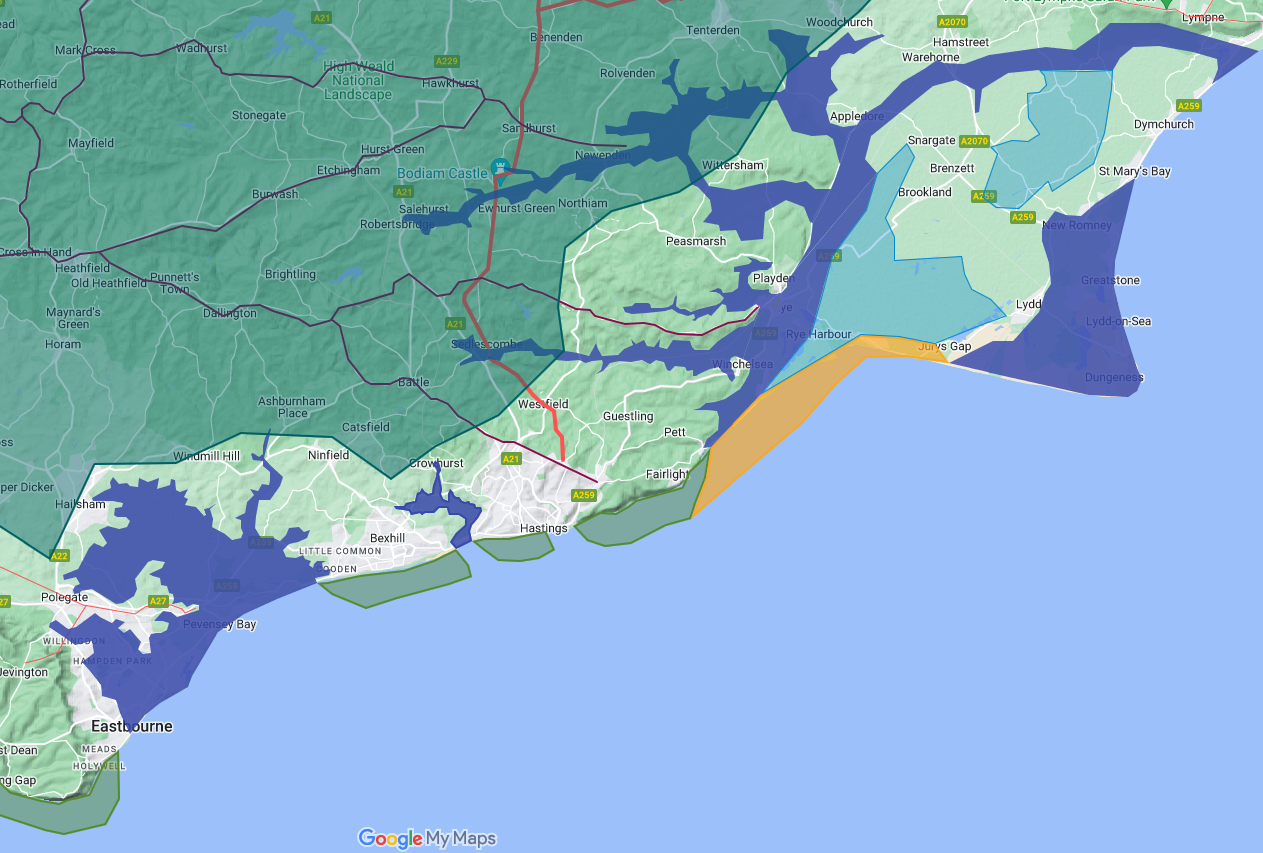
The green shaded area is the Great Forest of Anderida, the coastline shows variations due to high tide level changes and
the Rother reaching the sea at Hythe. The eroded cliffs are now shown about 1Km further into the English Channel. Known
Roman influences are shown as blue markers, with Bodiam as a major Roman Port.
Known Roman roads and ridgeways are shown going through the Forest. The main Roman iron production from the weald was
stopped after Carausius’s revolt in AD286 (Carausius controlled the Channel Fleet and also the main iron production
area in the Roman Empire), with the victorious Constantius just leaving enough iron production to continue making nails
for shipbuilding.
| | When was the Kingdom Settled? ▲ |
|---|
Timeline: (extracts from Anglo Saxon Chronicles)
449AD Martianus and Velentinian took over Britain and ruled it for 7 years(to AD456)
449AD The Angles are invited to Britain by Vortigern and landed at Ebbsfleet in Thanet
449AD they succeeded in taking over Kent for King Vortigern and were given land in South East Kent
455AD Henghest and Horsa fought King Vortigern at Rochester and took over
456AD they fought at Crayford and took over Kent (possibly killing Martianus and Velentinian)
477AD Aelle landed at Shoreham and fought the Britons and drove some into the Forest
485AD Aelle fought again at Binstead and took over Chichester
491AD Aelle attacked Pevensey and killed everyone there
495AD Cerdic and Cynric landed at Ichenor and fought the Britons
501AD Port landed at Portsmouth and killed more Britons
So the landings started in Kent and spread along the South coast towards the West, each invasion ignoring the land of
previous ones. So this would mean that the Kingdom of Hastings would have been settled between the final rule of
Martianus and Velentinian in AD465 and the landing of Aelle in AD477 a period of 12 years. �
Conclusion:
The Kingdom of the Haestingas is likely to have been settled sometime between AD465 and AD477, probably in the early
part of this time to allow them to expand before potentially coming into contact with Aelle and Henghest.
Invaders 1 - Henghest, Horsa and Æsc - conquest of
Kent
Invaders 3 - Aelle Cymen Wlenca Cissa - conquest of
West Sussex
| 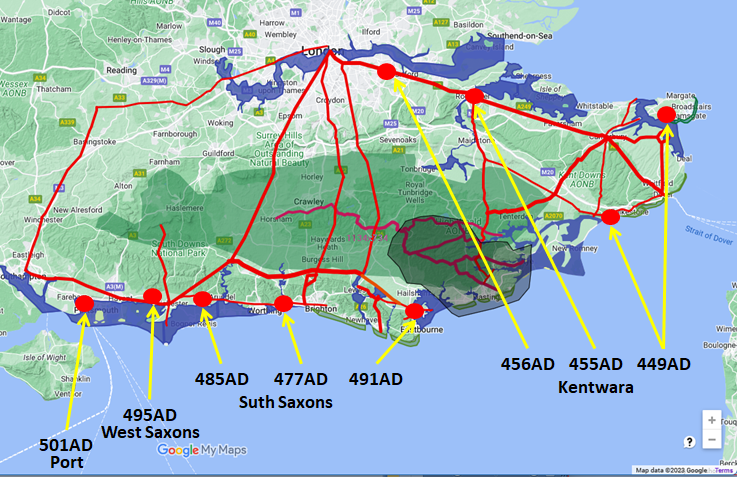
| | |
|---|
The Coastline overlayed with other Settlers ▲
|
|---|
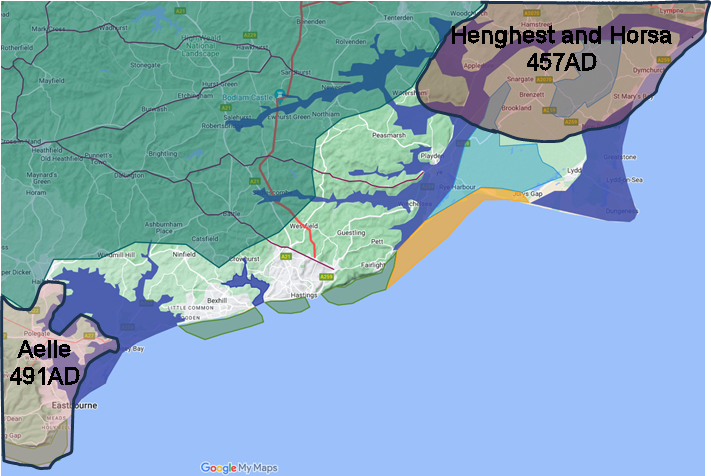
From the Anglo Saxon Chronicles we know that Henghest and Horsa take Kent in 457AD and Aelle takes Pevensey in 491AD,
this is shown on the map above, with the rest of the Saxons landing West of Aelle.
The area in between is the Haestingas, and was either settled by Saxons after 457AD, or was still held by the
Romano-British for shipbuilding.
However all the village names in this area are Saxon derived, so it's most likely the Saxons took over Hastings between
457AD and 491AD, but more likely before Aelle arrived in AD477 or he would probably have looked on a shipbuilding area
as a good place to invade and got there first.
Conclusion:
So the dates the area was settled must have been between 457AD and 477AD
| | |
|---|
| Where was the Kingdom? – The South Eastern Boundary ▲ |
|---|
A.D. 771. At this time Offa, king of the Mercians, subdued by arms the people of the Hestingi. (Symeon of Durham)
A.D. 796. Cynewulf, King of Mercia, made inroads upon the inhabitants of Kent as far as the marsh; and the Mercians
seized Edbert Pryn, their king, led him bound into Mercia, and suffered men to pick out his eyes, and cut off his
hands.(Anglo Saxon Chronicles)
The Chronicles appear to show the Eastern boundary of the Haestingas does not include the Romney Marsh or the marsh
wouldn’t have been included in the Kent victory, so lets assume Rye or less likely the Isle of Oxney as it is included
in modern Kent.
The original name for Rye was the Saxon ytera æg meaning the outer island, presumably that of the Kingdom
of the Haestingas.
The eastern boundary of modern Sussex also stops around Rye implying that the old boundary was also in this area.
Conclusion:
The South Eastern boundary of the Kingdom of the Haestingas is likely to be the old port of Rye.
| 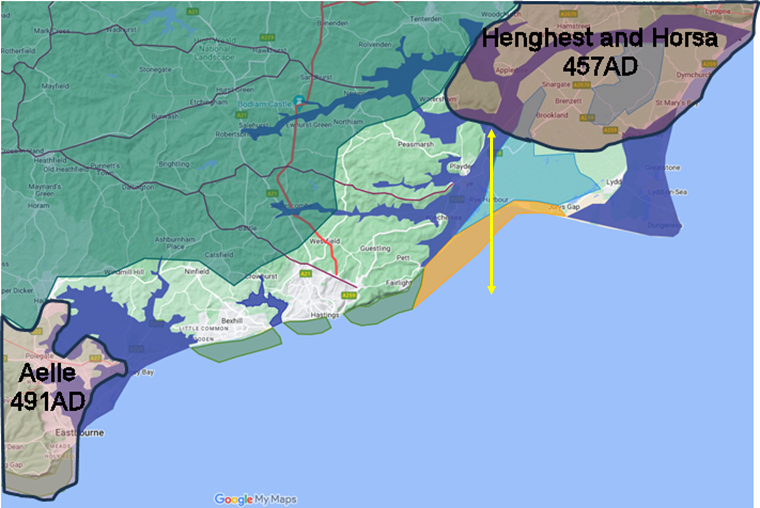
| | |
|---|
| Where was the Kingdom? – The South Western Boundary ▲ |
|---|
477AD Aelle came to Britain with his three sons Cymen, Wlenca and Cissa with three ships landing at the place called
Cymensora(Shoreham). There he killed many Welsh and drove some in flight into the forest of Andredsweald.
485AD Here Aelle defeated the 'Welsh' near Mearcredesburnan stede(Binstead – West Sussex).
491AD Aelle and Cissa besieged Anderida , near Pevensey, and killed all who were inside, so there was not one Briton
left.
Aelle landed at Shoreham then headed west to finally capture Chichester, then heads back to the East and has taken the
castle at Pevensey in 491AD thereby owning all the land between Roman Chichester and Pevensey Castle. There is no more
mention of any other battles or Aelle expansion to the East therefore the boundary must be to the East of Pevensey
Castle.
Conclusion:
The South Western boundary of the Kingdom of Haestings is likely to be to the East of Pevensey on the Hooe
peninsular.
| 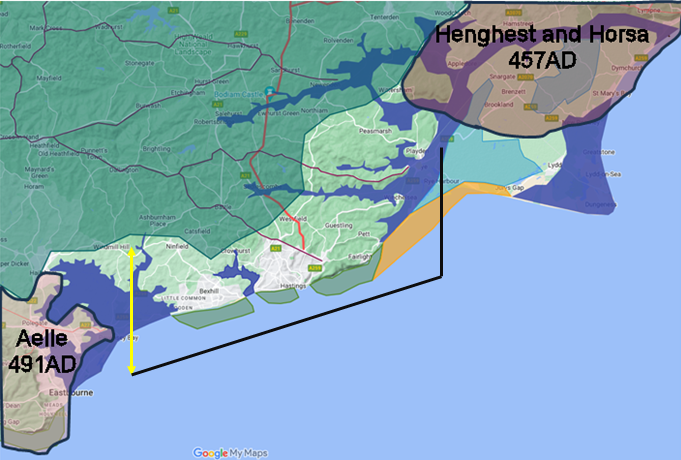
| | |
|---|
| Where was the Kingdom? – The North Eastern Boundary ▲ |
|---|
Hengest owns Kent, and the Roman fortress at Port Lympne and as far east as the Isle of Oxney.
The river Limen/Rother currently reaching the sea at Rye was at the time of the Jute/Saxon invasion reaching the sea at
Hythe, so the seaward end of the Rother is controlled by Kent.
The Rother valley was supplying the Romans with timber for shipbuilding and iron for ship nails and weapons.
It is therefore likely that the Jutes took over Oxney and took over the Roman shipbuilding there and probably further up
the Rother on the North side near to Newenden where the boundary would then follow the ridgeway towards Hawhurst. It
would seem likely that the modern County Boundary was moved to the Kent Ditch area sometime after the landing of the
Haestingas.
The Rother would provide a good defensive boundary between the Haestingas and the Kentwara (people of Kent). The
village names north of the rother include the ‘den’s which appears to be a Kentish name snippet, the only one south
of the river is Playden.
Conclusion:
The North Eastern boundary of the Kingdom of Haestings is likely to be on the Rother near Northiam, which is also the
modern boundary between Kent and Sussex.
| 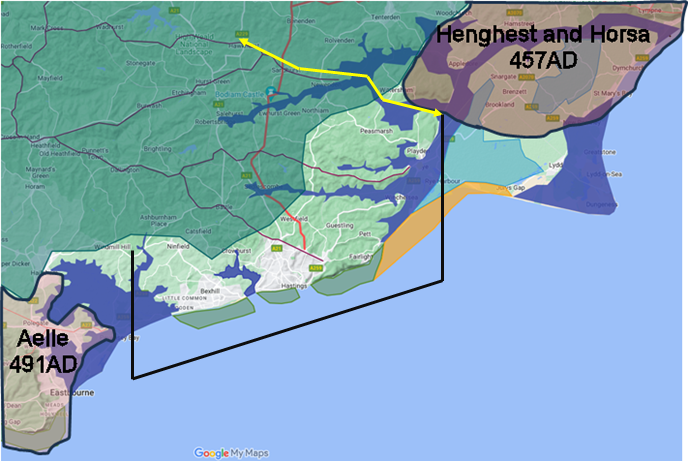
| | |
|---|
| Where was the Kingdom? – The North Western Boundary ▲ |
|---|
This is a much more complex issue as we have no direct evidence for this apart from the Sussex County Boundary, the
Roman roads and a stream crossing near Hadlow Down called Hastingsford.
Tribal boundaries in England were quite often along rivers/streams Hastingsford is on a tributary of the ouse called the
Uck (this can be translated from the Saxon as Oak appropriate for the Forest). This stream leads up to Rotherfield which
is also the source of the river Rother.
There is an area in Rotherfield called Castle Hill which lies on the boundary between the Uck and the Rother and is also
on the strategic joining point of two Ridgeways. Places with snippet names ‘Castle something’ would seem most likely
to be old Roman Catellums, watch towers.
The northern boundary probably follows the Sussex border and the ridge from Flimwell through to Mark Cross or Frant.
The logic for the area covered is that the main ridgeways from Hastings merge at Rotherfield where they pass on to
Crowborough. This is a good strategic place to stop invaders from the West as it provides a single bottleneck in the
Forest. Aelle had taken the whole area South of the Forest so would also have come up the London Lewes Roman road to
Crowborough so stopping any westward movement by the Haesingaes.
Conclusion:
The North Western boundary of the Kingdom of Haestings is likely to at Hastingsford near Hadlow Down.
| 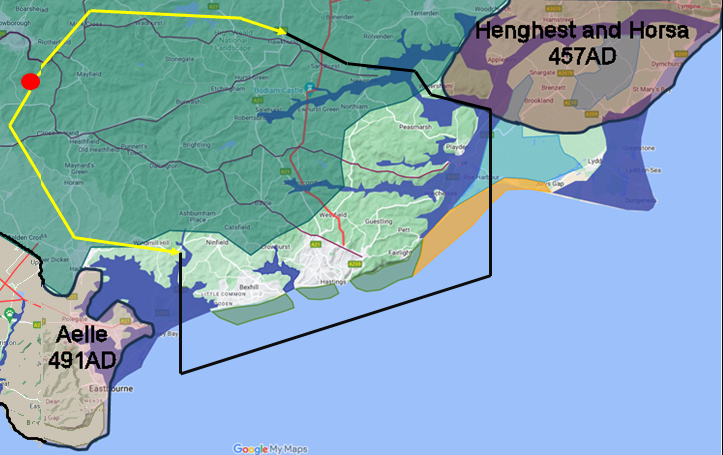
| | |
|---|
| Where was the Port of the Haestingas ? ▲ |
|---|
We now have the area of the Kingdom, but the Saxons were seafarers so would need a port for their base, there are only 3
possibilities, the Brede Valley, Combe Haven and the Ashbourne valley as all East and West bound valleys are occupied by
Jutes or Britons in very strong Roman forts.
The Ashbourne valley is too near to Pevensey Castle which was occupied at the time by the Britons as Aelle hadn’t
taken the fortress at the time. There is also a possibility due to the high tide level changes and the shape of Pevensey
Bay that there was a tidal bore at Boreham Street.
The Brede valley would have had limited use as the Romans had denuded the area of any trees which could have been used
for houses and shipbuilding and by burning the wood for the production of iron and also the Rother reached the sea at
Hythe. The original name for Rye was the Saxon ytera æg meaning the outer island again implying that is wasn’t that
close to the Port of Hastings.
This only leaves Combe Haven (translates as a port enclosed by hills ) which would have provided good shelter from the
prevailing winds and is right on the edge of Anderida providing copious supplies of wood. Also there is an area at the
valley entrance known as Bulverhythe, a hythe seems to have been an important landing place, and Bulver is derived from
burgh wara meaning the people(wara) of either the hill(beorg) or fort(burh).
Conclusion:
The best logic provides a protected sea port in the modern Filsham valley that would have provided a haven for the
ships, and was near enough to the Forest and Iron workings to be able to be a shipyard for the Hastings Fleet.
| 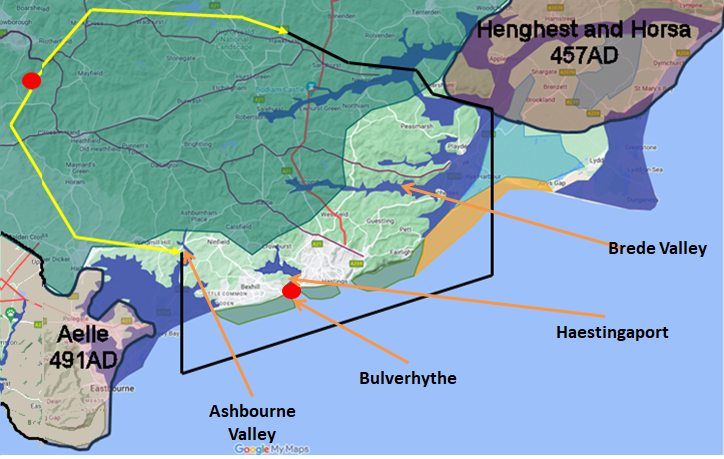
| | |
|---|
| The meaning of the name ? ▲ |
|---|
Hastings is a Saxon word, the snippet hast derives from hǽste meaning violent, vehement or impetuous, this could relate
to the sea in the area, or could come from a warriors name.
Another possibility is that it derives from the Latin hasta which is the generic term for spears, which the Romans may
have been making in the area prior to the Saxon invasion.
The ing snippet usually derives from nering meaning defended or protected, most likely via a pallisade.
Hence Hǽste ing
Meaning either:
The Roman Spear fort
The fort by the violent sea
The fort protected from the violent sea
The fort of hǽste the violent warrior
Conclusion
Actually I don't know which one it could be as all have merits, but I think my preference is 'The fort protected
from the violent sea', but thats just a preference.
| | The economics of the Kingdom of Hastings ▲ |
|---|
For this we need to start with the Romans who had occupied the area since 43AD.
It is very likely that this iron rich area with its vast forest containing oak was the main reason for their
invasion.
The following figures come from research by the Wealden Iron Research Group
1st Century iron production was about 420 tons per year from small bloomeries
2nd Century was 630 tons per year as the bloomeries become more industrialised
3rd Century was lower at about 360 tons per year, but this was probably caused by Carausius’s revolt in AD286
reducing production, with Rome finally moving iron production for weapons to other parts of the empire.
4th Century now just a trickle at about 40 tons per year, probably just used for shipbuilding.
After the Romans left there is very little evidence remaining for major iron working in the area until the
1200’sAD (Wealden Iron Research Group)
The Forest of Andredsweald reaching the sea at Pevensey, Crowhurst and the Rother valley contained a great deal of the
hardest oak trees in europe, so that shipbuilding by the Romans became important to provide vessels to transport goods
to and from mainland Europe, and to build the Roman fighting ships the liburnae to protect these merchantmen.
The defeat of the Carausian revolt in AD296 by Constantinus gave the Romans a choice, either stop iron production or
shipbuilding, as a single commander holding both could take control. There were iron reserves in other parts of the
empire but no other sources of this very hard oak so the main iron production was moved to a number of other European
sites and reduced in this area to a level that was only sufficient for shipbuilding.
This is my conclusion of the late Roman Empire in Britannia, and it would appear to fit the facts,
but your ideas may be better so please let me know of any you might have
| 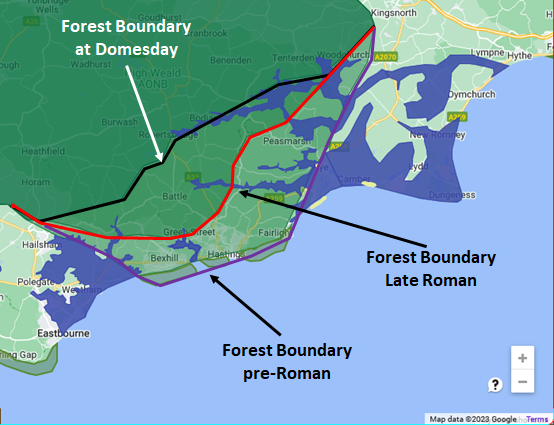
| | |
|---|
| Surrounding Defenses ▲ |
|---|
The next map shows a plot of the settlements containing the Saxon snippet 'ing' translated from the Saxon
'nering' meaning protected or pallisaded, these seem to surround the area or are on strategic routes.
They seem to be mostly in a ring around the Hastings area and are mostly along strategic roads, ridges or valleys.
Please look at my pages on 'ings'
| 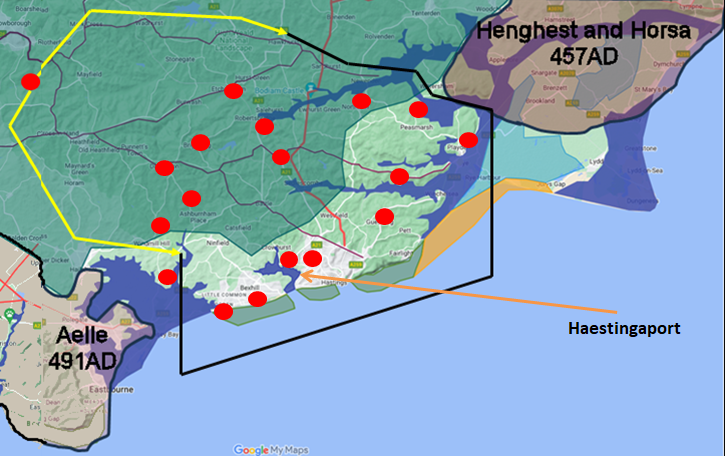
| | |
|---|
| The Domesday and the Rape of Hastings ▲ |
|---|
A Rape was an area from the Domesday Book, which defined a Lords domain. The word derives from rope and appears as a
rough boundary around Hastings, but includes a lot of the area we have previously identified as the Kingdom of Hastings.
The map below shows the Domesday villages and the Forest of Andredsweald and the area of the Rape.
| 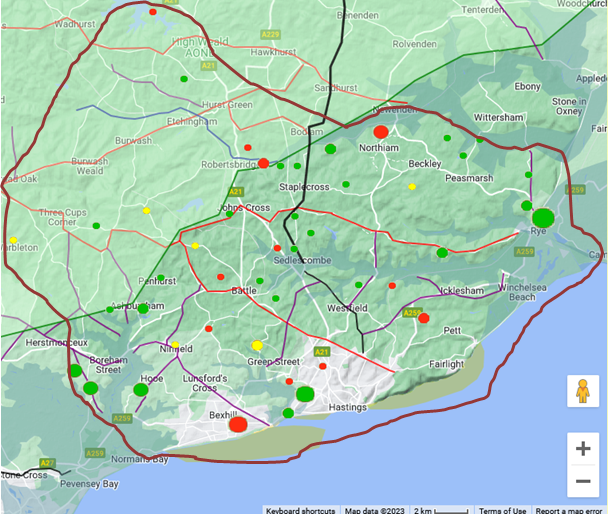
The map below was produced by Thomas Allason in 1819 and shows the Rape of Hastings.
| 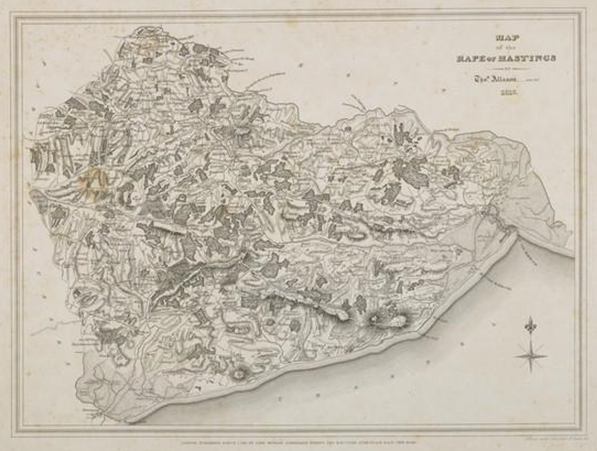
Please click on this image to view a zoomable map from the National Galleries website.
| | Other historic details of the area post King Offa and pre Norman ▲ |
|---|
692AD. Nothhelm (Nunna), king of Sussex, grants to his sister Nothgyth, 33 hides (cassati) at Lidsey, Aldingbourne,
Lenstedegate (? Westergate in Aldington) and (North) Mundham, Sussex to found a minster, this is signed by two kings
Nunna of the South Saxons and Watta possibly of Hastings.
771AD King Offa of Mercia conquered the area.
The area was very isolated with only a few ridgeways or Roman roads leaving to the rest of the country, this means that
it is unlikely that Hastings was an import/export port until some time after 1066AD when more of the forest was removed
and the land communications links improved. So the only conclusion is that for King Offa to take over this independent
area it must have been important for something, even if only for his conquest, but it would also most likely for
shipbuilding.
914 AD The Burghal Hideage, Alfred the Great’s list of defensive forts for Wessex
describes a Burh(fort) at
Hastings. This was the most Eastward of Alfred’s forts and was designed to prevent the taking over of an area by the
Danes/Vikings.(most likely location is Baldslow Down Landscape - Alfred the Greats fort in Hastings)
924 AD King Athelstan had a mint at Hastings.
The two above features imply that Hastings was very important to Wessex, again probably for its shipbuilding.
1066AD This now begs the question:
‘WHY DID WILLIAM INVADE AN ISOLATED SAXON PORT ON THE SOUTH COAST ?’
the answer is that this was most likely one of the Saxon’s main shipbuilding areas in the country and William knew it
would draw Harold down for the battle very quickly, or he would loose control of his fleet production area and his
navy.
Battle of Hastings 1066AD - C - Why
Hastings?
Further reading on Hastings:
Landscape - Alfred the Greats fort in
Hastings
Battle Historical Society on the Rapes of Sussex
|
|
|
|
|
| |
|
|
Local Interest
Just click an image |
|
|
|
|
|
|
|
|
|
|
|
|
| |
|
|